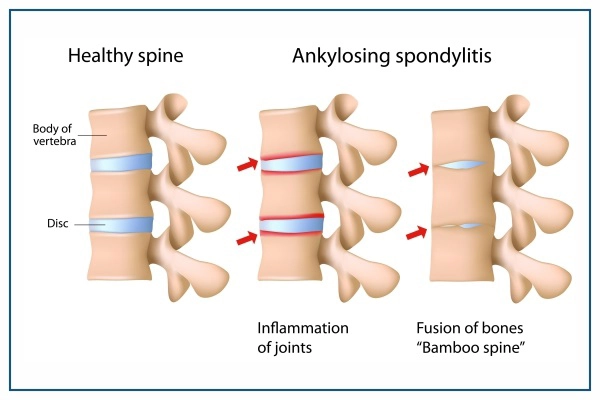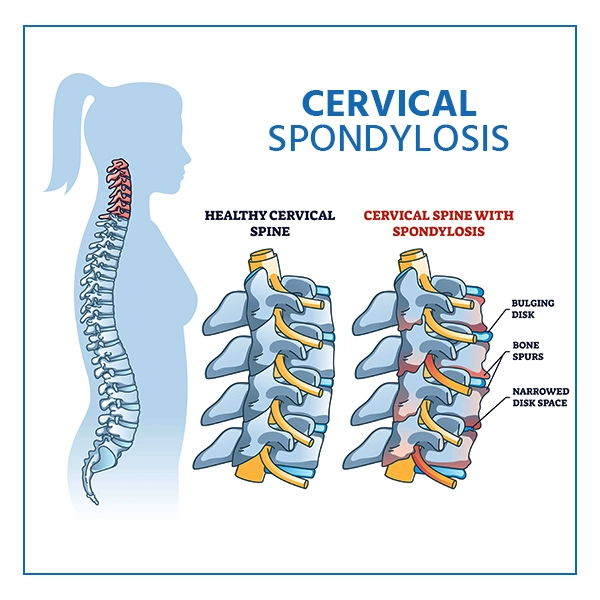What is Spondylosis?
Spondylosis is a type of arthritis, specifically spinal osteoarthritis. Arthritis doesn't just affect the hands and knees but also the spine, bones, and joints. It's caused by wear and strain. Over 80% of adults over 40 have it, especially lumbar spondylosis in that age group.
Spondylosis symptoms differ but usually don't cause major issues. Commonly, there's occasional pain and stiffness.

Secure your health with a second opinion. Make informed decisions and book your appointment today!
Get A Second OpinionSpondylosis symptoms
Spondylosis can damage any joint along the spine, and it is most frequent in the neck and lower back.
The stages of Spondylosis disease
- Early Spondylosis : Starts at the hip joint near the spine base. Pain may spread gradually over weeks to both sides and hips. Movement alleviates soreness, but it persists over time. Symptom-free periods occur between flare-ups.
- Progressing Spondylosis : Gradually moves up the spine to the neck. Imaging (like MRI) assesses severity. Initially hard to detect, changes become more apparent. It may affect areas beyond the spine, causing discomfort in the ribs, shoulders, hips, thighs, or heels.
- Advanced Spondylosis : Severe cases may lead to spine fusion, reducing motion. Repeated fusion can restrict spine movement entirely. Increased risk of fractures and forward spine tilt may occur, resulting in a hunched position. Physical therapy can help.
What are the causes of spondylosis?
Years of continual wear and tear causes alteration in your spine as you age. In middle age, the discs within your vertebrae deteriorate. Other causes of this medical condition are:
- Degenerative Disc Disease (DDD): Changes occur in your discs, but the ageing process gradually affects the other mobility segments of the vertebrae. (The discs and facet joints are called motion segments, which implies they assist you in moving). The disc will be less porous and much thinner as it ages. A thinner disc reduces the space between the vertebrae above and below the disc, causing a new set of problems with the facet joints.
- Spinal Movement Disturbance: Another alteration in your spine is caused by hypermobility. It attempts to halt movement by growing microscopic bony pieces known as bone spurs (osteophytes). Unfortunately, bone spurs can squeeze nerve structures, causing discomfort.
- Genetics : Family history can predispose you to excessive bone and disc wear, increasing the risk of spondylosis.

What are the risk factors of spondylosis?
The most important risk factor for Spondylosis is ageing. It causes dehydration, disc herniation, and bone spurs.
Risk factors for Spondylosis are as follows
- Weight and inactivity
- Neck injuries
- Prolonged discomfort
- Genetics
- Smoking
- Certain jobs
- Aging
What are the complications of spondylosis?
Complications of Spondylosis are as follows:
- Compression of the Nerves: Prolonged pressure on spinal nerves can lead to cervical radiculopathy, causing varied symptoms.
- Stenosis of the Spine: Untreated Spondylosis may progress to spinal canal narrowing, known as spinal stenosis, which can potentially injure the spinal cord.
What is the prevention of spondylosis?
Preventing spondylosis include:
- Assess spine contour and abnormalities.
- Check for painful spots, stiffness, spasms, lumps, or inflammation.
- Evaluate pain level, weakness, or tingling.
- Conduct X-rays to detect bone spurs or disc degeneration signs.
- Order CT or MRI scans for soft tissue examination.
- Additional tests based on symptoms may be required.
What are the treatments for spondylosis?
Here are some common approaches:
- Manage symptoms with medication or self-care.
- Use over-the-counter NSAIDs like ibuprofen for pain.
- Stay active with exercises like walking or rowing.
- Improve posture and consider physiotherapy.
- Use supportive furniture for the back.
- Rest during flare-ups.
Ready to take control of your health journey? Book your appointment now and start your path towards wellness today!
Book an AppointmentFrequently Asked Questions
Treatments focus on symptom management, but there's no definitive cure.
It's a fracture in a cervical vertebra, causing neck pain.
You can use online directories, ask for referrals, or directly contact Medicover Hospitals to find a spondylosis specialist nearby.
Practice good posture, exercise, use heat/ice packs, and avoid aggravating activities.
Diagnostic tests to assess spine alignment and nerve function may include X-rays, MRI scans, CT scans, and physical examinations.
